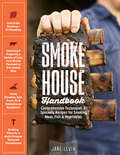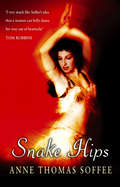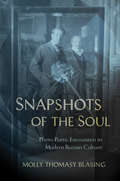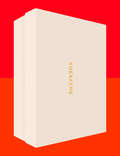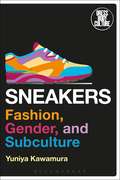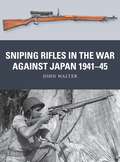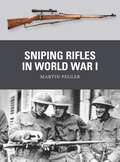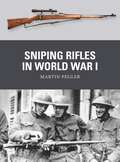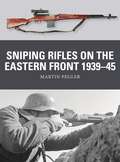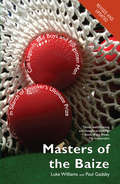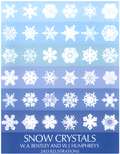- Table View
- List View
Smoke and Mirrors: The Yenidze Cigarette Factory, Dresden (Space and Place #22)
by David NielsenThe Yenidze Cigarette Factory of 1909 was constructed as an industrial, architectural object that advertised Dresden as a center for the tobacco trade. Born from a unique client-architect relationship between Hugo Zietz and Martin Hammitzsch, the factory’s importance to modernism has been understated. Smoke and Mirrors uncovers the history of the factory’s planning, design, and construction, and for the first time, apart from the building’s historical narrative, positions this addition to Dresden’s skyline within the formative histories of the modern movement.
Smokehouse Handbook: Comprehensive Techniques & Specialty Recipes for Smoking Meat, Fish & Vegetables
by Jake LevinA comprehensive guide to cold-smoking, hot-smoking, and pit-roasting techniques from a master butcher who provides expert advice on every aspect of selecting, preparing, and cooking meat, fish, and vegetables.
Snails and Monkey Tails
by Michael ArndtAn entertaining, informative, and elegantly designed guide that makes understanding punctuation marks and symbols simple and fun. A rollicking linguistic ride for fans of Eats, Shoots & Leaves and Just My Type.
Snake Charming - The Musical Python
by Iain GrayThis book is an innovative introduction to Python and its audio-visual capabilities for beginning programmers; a resource for expert programmers and of interest to anyone involved in music. It is structured around four extensible, audio-visual projects on music and sound. The beginner will appreciate the 'need to know' basis of the presentation of Python for each project, and expert programmers will be able to go straight to the project code, run it and then extend it as they see fit. Musically interested readers will enjoy the historical and theoretical material at the beginning of each project, and it may even tempt them to try some coding - it is not too difficult! The four projects the book focuses on are all self-contained, but can be extended to incorporate aspects of the others. Above all this book is suited for self-study, which should be playful (pun intended!).
Snake Hips: Belly Dancing And How I Found True Love
by Anne Thomas SoffeeSNAKE HIPS follows an Arab-American woman's life as she shimmies her way from getting dumped by her tattoo-artist boyfriend to coming to grips with being single, ample, and 30. Her heart broken, Soffee moves back home to wallow in self-pity. There she comes across a flier advertising the usual classes in yoga, vegetarian cookery, ballet and...belly dancing. Against the wishes of her extended family and friends, she enrols, hoping to heal her heart and reconnect with her Lebanese roots. Soffee soon discovers that her life will never be the same after she enters the riotous world of belly dancing, a warm and welcoming subculture where younger and thinner are not necessarily better. Soffee's ethnic high leads to Princess Jasmine fantasies - for example, being 'third-favourite wife' to a sheik she is cyber-dating, a perfect relationship until she realizes that being obedient is easier online. Then she falls for a beautiful Lebanese boy-next-door. Among the zils (finger cymbals) and thrills of performing in moose lodges and county fairs, Soffee is surprised to find happiness and true love along the way.
Snapdragon: The World War II Exploits of Darby's Ranger and Combat Photographer Phil Stern
by Liesl Bradner Phil SternPrior to Phil Stern's death on December 13, 2014, his original, unfinished, tattered wartime memoir was discovered, stashed away in an old folio box in his cluttered Hollywood bungalow. Best remembered for his iconic images of James Dean, Marilyn Monroe, and JFK's inauguration, his remarkable service during World War II as a combat photographer with Darby's Rangers has remained largely unknown. Until now.Stern's catchy 1940s lingo, honest and intimate observations, and humor, paired with his striking combat photography, transport the reader 70 years back in time to meet the hardscrabble Rangers and experience some of the key battles of the Mediterranean Theater. Snapdragon is an artifact of that time, told not by a man reminiscing in his twilight years, but by a young soldier fresh from the battlefields.
Snapdragon: The World War II Exploits of Darby's Ranger and Combat Photographer Phil Stern
by Liesl Bradner Phil SternPrior to Phil Stern's death on December 13, 2014, his original, unfinished, tattered wartime memoir was discovered, stashed away in an old folio box in his cluttered Hollywood bungalow. Best remembered for his iconic images of James Dean, Marilyn Monroe, and JFK's inauguration, his remarkable service during World War II as a combat photographer with Darby's Rangers has remained largely unknown. Until now.Stern's catchy 1940s lingo, honest and intimate observations, and humor, paired with his striking combat photography, transport the reader 70 years back in time to meet the hardscrabble Rangers and experience some of the key battles of the Mediterranean Theater. Snapdragon is an artifact of that time, told not by a man reminiscing in his twilight years, but by a young soldier fresh from the battlefields.
Snapshots of Museum Experience: Understanding Child Visitors Through Photography (Routledge Research in Museum Studies)
by Elee Kirk Will BuckinghamChildren are one of the major audiences for museums, but their visits are often seen solely from the point of view of museum learning. In Snapshots of Museum Experience, Will Buckingham draws upon Elee Kirk’s research amongst child visitors to the Oxford University Museum of Natural History, to take a different approach. Using a method of photo-elicitation with four-and five-year-old child visitors to the museum, the book investigates children’s experience of the museum, and in the process undermines many of our assumptions about the interests, needs and demands of child museum visitors. Drawing together the fields of museum studies and childhood studies, the book considers children as active creators of the museum visit. It investigates the way that children navigate and take control of the physical and social spaces of the museum, finding their own idiosyncratic pathways through these spaces. It also explores how elements of the museum ‘light up’, becoming salient to the child visitor. Finally, it investigates how children make sense through intellectually and imaginatively engaging with these elements of the museum visit. Snapshots of Museum Experience gives a unique insight into the sheer diversity of children’s museum experiences and discusses how museums might cater more successfully to the needs of their child visitors. As such, it should be of great interest to academics, researchers and students in the fields of museum studies, visitor studies and childhood studies. It should also be essential reading for museum educators and exhibition designers.
Snapshots of Museum Experience: Understanding Child Visitors Through Photography (Routledge Research in Museum Studies)
by Elee Kirk Will BuckinghamChildren are one of the major audiences for museums, but their visits are often seen solely from the point of view of museum learning. In Snapshots of Museum Experience, Will Buckingham draws upon Elee Kirk’s research amongst child visitors to the Oxford University Museum of Natural History, to take a different approach. Using a method of photo-elicitation with four-and five-year-old child visitors to the museum, the book investigates children’s experience of the museum, and in the process undermines many of our assumptions about the interests, needs and demands of child museum visitors. Drawing together the fields of museum studies and childhood studies, the book considers children as active creators of the museum visit. It investigates the way that children navigate and take control of the physical and social spaces of the museum, finding their own idiosyncratic pathways through these spaces. It also explores how elements of the museum ‘light up’, becoming salient to the child visitor. Finally, it investigates how children make sense through intellectually and imaginatively engaging with these elements of the museum visit. Snapshots of Museum Experience gives a unique insight into the sheer diversity of children’s museum experiences and discusses how museums might cater more successfully to the needs of their child visitors. As such, it should be of great interest to academics, researchers and students in the fields of museum studies, visitor studies and childhood studies. It should also be essential reading for museum educators and exhibition designers.
Snapshots of the Soul: Photo-Poetic Encounters in Modern Russian Culture
by Molly Thomasy BlasingSnapshots of the Soul considers how photography has shaped Russian poetry from the early twentieth century to the present day. Drawing on theories of the lyric and the elegy, the social history of technology, and little-known archival materials, Molly Thomasy Blasing offers close readings of poems by Boris Pasternak, Marina Tsvetaeva, Joseph Brodsky, and Bella Akhmadulina, as well as by the late and post-Soviet poets Andrei Sen-Sen'kov, Arkadii Dragomoshchenko, and Kirill Medvedev, to understand their fascination with the visual language, representational power, and metaphorical possibilities offered by the camera and the photographic image. Within the context of long-standing anxieties about the threat that visual media pose to literary culture, Blasing finds that these poets were attracted to the affinities and tensions that exist between the lyric or elegy and the snapshot. Snapshots of the Soul reveals that at the core of each poet's approach to "writing the photograph" is the urge to demonstrate the superior ability of poetic language to capture and convey human experience.
Sneakers: Over 300 classics from rare vintage to the latest kicks
by Neal HeardADIDAS SUPERSTAR. NIKE AIR MAX. ONITSUKA TIGER CORSAIR. BALENCIAGA TRIPLE S. YEEZY 700. STAN SMITH. VANS OLD SKOOL. AIR JORDAN.With over 300 styles and including all the essential trends and brands, this is the ultimate sneaker handbook.
Sneakers
by Howie Kahn Alex French Rodrigo CorralAn absolute necessity for design devotees and sneakerheads of all ages. Sneakers is a definitive exploration of the creative energy, innovation, collaboration, and visionary intelligence behind the cultural phenomenon of sneakers.
Sneakers: Fashion, Gender, and Subculture (Dress, Body, Culture)
by Yuniya KawamuraThis is the first academic study of sneakers and the subculture that surrounds them. Since the 1980s, American sneaker enthusiasts, popularly known as “sneakerheads” or “sneakerholics”, have created a distinctive identity for themselves, while sneaker manufacturers such as Reebok, Puma and Nike have become global fashion brands. How have sneakers come to gain this status and what makes them fashionable? In what ways are sneaker subcultures bound up with gender identity and why are sneakerholics mostly young men? Based on the author's own ethnographic fieldwork in New York, where sneaker subculture is said to have originated, this unique study traces the transformation of sneakers from sportswear to fashion symbol. Sneakers explores the obsessions and idiosyncrasies surrounding the sneaker phenomenon, from competitive subcultures to sneaker painting and artwork. It is a valuable contribution to the growing study of footwear in fashion studies and will appeal to students of fashion theory, gender studies, sociology, and popular culture.
Sneakers: Fashion, Gender, and Subculture (Dress, Body, Culture)
by Yuniya KawamuraThis is the first academic study of sneakers and the subculture that surrounds them. Since the 1980s, American sneaker enthusiasts, popularly known as “sneakerheads” or “sneakerholics”, have created a distinctive identity for themselves, while sneaker manufacturers such as Reebok, Puma and Nike have become global fashion brands. How have sneakers come to gain this status and what makes them fashionable? In what ways are sneaker subcultures bound up with gender identity and why are sneakerholics mostly young men? Based on the author's own ethnographic fieldwork in New York, where sneaker subculture is said to have originated, this unique study traces the transformation of sneakers from sportswear to fashion symbol. Sneakers explores the obsessions and idiosyncrasies surrounding the sneaker phenomenon, from competitive subcultures to sneaker painting and artwork. It is a valuable contribution to the growing study of footwear in fashion studies and will appeal to students of fashion theory, gender studies, sociology, and popular culture.
Sniper Rifles: From the 19th to the 21st Century (Weapon)
by Peter Dennis Martin PeglerA technical outline of the history of the sniper rifle, from its introduction in warfare during the Napoleonic wars, through the US Civil War to its current apogee as the most frequently used combat rifle in Iraq and Afghanistan. This book details the development of ammunition, different weapons types including single shot, magazine loading and semi-automatic, as well as the introduction and use of optical sights. Martin Pegler, a leading expert on the history of sniping and former Senior Curator of Firearms at the Royal Armouries Leeds, also details the current advances in technology, such as laser range-finding sights and night vision devices. Using first-hand accounts, the book brings the dangerous world of the sniper to life revealing their training and concealment techniques as well as their mastering of their weapon of choice.
Sniper Rifles: From the 19th to the 21st Century (Weapon #6)
by Peter Dennis Martin PeglerA technical outline of the history of the sniper rifle, from its introduction in warfare during the Napoleonic wars, through the US Civil War to its current apogee as the most frequently used combat rifle in Iraq and Afghanistan. This book details the development of ammunition, different weapons types including single shot, magazine loading and semi-automatic, as well as the introduction and use of optical sights. Martin Pegler, a leading expert on the history of sniping and former Senior Curator of Firearms at the Royal Armouries Leeds, also details the current advances in technology, such as laser range-finding sights and night vision devices. Using first-hand accounts, the book brings the dangerous world of the sniper to life revealing their training and concealment techniques as well as their mastering of their weapon of choice.
Sniping Rifles in the War Against Japan 1941–45 (Weapon #88)
by John WalterFully illustrated, this absorbing study explores the evolving sniping technology and tactics employed by both sides in Asia and the Pacific during 1941–45. During World War II, both the Japanese and their Allied opponents made widespread use of snipers armed with a variety of rifles, scopes and accessories and prepared by widely differing levels of training and tactical doctrine. The challenges of fighting in a variety of harsh environments, from the Pacific islands to the vast expanses of China, prompted improvisation and innovation on both sides in the ongoing war between snipers and their adversaries. Often operating at relatively close ranges in restrictive terrain, snipers made particularly ingenious use of camouflage and deception as the fighting spread across Asia and the Pacific in the wake of the Pearl Harbor attack, while troops tasked with countering enemy marksmen had to learn the hard way how best to defeat a seemingly invisible enemy. Small arms expert John Walter considers the strengths and limitations of the rifles, scopes and accessories deployed by Japanese snipers and their Allied counterparts, as well as their different approaches to sniping tactics and training. Specially commissioned artwork and carefully chosen photographs illustrate this enthralling study of the sniping war in Asia and the Pacific during World War II.
Sniping Rifles in the War Against Japan 1941–45 (Weapon #88)
by John WalterFully illustrated, this absorbing study explores the evolving sniping technology and tactics employed by both sides in Asia and the Pacific during 1941–45. During World War II, both the Japanese and their Allied opponents made widespread use of snipers armed with a variety of rifles, scopes and accessories and prepared by widely differing levels of training and tactical doctrine. The challenges of fighting in a variety of harsh environments, from the Pacific islands to the vast expanses of China, prompted improvisation and innovation on both sides in the ongoing war between snipers and their adversaries. Often operating at relatively close ranges in restrictive terrain, snipers made particularly ingenious use of camouflage and deception as the fighting spread across Asia and the Pacific in the wake of the Pearl Harbor attack, while troops tasked with countering enemy marksmen had to learn the hard way how best to defeat a seemingly invisible enemy. Small arms expert John Walter considers the strengths and limitations of the rifles, scopes and accessories deployed by Japanese snipers and their Allied counterparts, as well as their different approaches to sniping tactics and training. Specially commissioned artwork and carefully chosen photographs illustrate this enthralling study of the sniping war in Asia and the Pacific during World War II.
Sniping Rifles in World War I (Weapon)
by Martin PeglerWhile Germany and Austria-Hungary were well-equipped with sniping rifles in 1914, their Allied opponents were not. This highly illustrated volume tells the inside story of the rifles carried by snipers of all the major powers during World War I.Although military sharpshooting had existed since the 18th century, in 1914 only the German and Austro-Hungarian armies fielded trained snipers armed with scoped rifles. Thus upon the outbreak of World War I, the Allied armies found themselves on the receiving end of a shooting war to which they had no means of response. Only the Canadians brought a dedicated sniping rifle into the trenches, but in small numbers. For the British, although production of a suitable rifle and scope were settled on quickly, the establishment of sniper training was difficult and its success was mostly due to the efforts of a handful of dedicated officers. The French eventually introduced a competent scoped rifle and a sniper training system, as did the Italians. Entering the war in 1917, the Americans experienced rifle shortages but were able to build on their pre-1914 efforts to find a suitable sniping weapon. The country that suffered most grievously was Russia; Russian troops fielded no snipers at all and suffered accordingly. Featuring full-colour artwork, carefully chosen archive images and photographs of the sniping rifles and accessories used in the trenches, this is the inside story of the rifles carried by snipers of all the major powers during World War I.
Sniping Rifles in World War I (Weapon)
by Martin PeglerWhile Germany and Austria-Hungary were well-equipped with sniping rifles in 1914, their Allied opponents were not. This highly illustrated volume tells the inside story of the rifles carried by snipers of all the major powers during World War I.Although military sharpshooting had existed since the 18th century, in 1914 only the German and Austro-Hungarian armies fielded trained snipers armed with scoped rifles. Thus upon the outbreak of World War I, the Allied armies found themselves on the receiving end of a shooting war to which they had no means of response. Only the Canadians brought a dedicated sniping rifle into the trenches, but in small numbers. For the British, although production of a suitable rifle and scope were settled on quickly, the establishment of sniper training was difficult and its success was mostly due to the efforts of a handful of dedicated officers. The French eventually introduced a competent scoped rifle and a sniper training system, as did the Italians. Entering the war in 1917, the Americans experienced rifle shortages but were able to build on their pre-1914 efforts to find a suitable sniping weapon. The country that suffered most grievously was Russia; Russian troops fielded no snipers at all and suffered accordingly. Featuring full-colour artwork, carefully chosen archive images and photographs of the sniping rifles and accessories used in the trenches, this is the inside story of the rifles carried by snipers of all the major powers during World War I.
Sniping Rifles on the Eastern Front 1939–45 (Weapon)
by Martin PeglerThe Soviet Union had developed a significant sniping force by 1939, but the extraordinary skill and cunning displayed by Finnish snipers during the Winter War forced the Soviets to innovate. On the other side, German sniping suffered from a lack of standardization of weapons and a lack of marksmen deployed at the start of the Great Patriotic War (1941–45). There were few heroes in the conflict, but on both sides, the snipers were idolized – especially on the Soviet side, gaining almost mythical status.As well as traditional bolt-action weapons, both sides used several types of semi-automatic rifle, such as the SVT-38 and the Gew 41. Offering greater firepower at the expense of long-range accuracy, such weapons would be profoundly influential in the postwar world. Fully illustrated, this absorbing study investigates the development of sniping weapons and techniques on World War II's Eastern Front.
Sniping Rifles on the Eastern Front 1939–45 (Weapon #67)
by Martin PeglerThe Soviet Union had developed a significant sniping force by 1939, but the extraordinary skill and cunning displayed by Finnish snipers during the Winter War forced the Soviets to innovate. On the other side, German sniping suffered from a lack of standardization of weapons and a lack of marksmen deployed at the start of the Great Patriotic War (1941–45). There were few heroes in the conflict, but on both sides, the snipers were idolized – especially on the Soviet side, gaining almost mythical status.As well as traditional bolt-action weapons, both sides used several types of semi-automatic rifle, such as the SVT-38 and the Gew 41. Offering greater firepower at the expense of long-range accuracy, such weapons would be profoundly influential in the postwar world. Fully illustrated, this absorbing study investigates the development of sniping weapons and techniques on World War II's Eastern Front.
Snooker's World Champions: Masters of the Baize
by Luke Williams Paul GadsbyThe top snooker players in the world compete for several trophies every year, but one carries more prestige than all the others put together - the World Championship. No other tournament in the sport carries with it so much history, so many golden moments of spectacular success and dramatic failure. Meticulously researched and including exclusive interview material with Steve Davis, Stephen Hendry and 2005 world champion Shaun Murphy, among others, Masters of the Baize is a comprehensive guide to the men who have lifted the greatest prize in snooker. From the legendary Joe Davis, the first champion in 1927, to modern-day masters like Mark Williams, all the sport's world champions are put under the microscope, while the colourful careers of forgotten figures such as Walter Donaldson and John Pulman and rogue heroes like Alex Higgins and Ronnie O'Sullivan are brought vividly to life. After uncovering the inauspicious origins of the game in nineteenth-century India, the authors examine every former world champion in his own comprehensive chapter. Additionally, a special section focuses on the extraordinary popularity of Jimmy White, by far the greatest player never to have won the title and one of the most emotive names in the sport.
Snow Crystals
by W. A. Bentley W. J. HumphreysDid you ever try to photograph a snowflake? The procedure is very tricky. The work must be done rapidly in extreme cold, for even body heat can melt a rare specimen that has been painstakingly mounted. The lighting must be just right to reveal all the nuances of design without producing heat. But the results can be rewarding, as the work of W. A. Bentley proved. <p><p> For almost half a century, Bentley caught and photographed thousands of snowflakes in his workshop at Jericho, Vermont, and made available to scientists and art instructors samples of his remarkable work. In 1931, the American Meteorological Society gathered together the best of these photomicrographs, plus some slides of frost, glaze, dew on vegetation and spider webs, sleet, and soft hail, and a text by W. J. Humphreys, and had them published. That book is here reproduced, unaltered, and unabridged. Over 2,000 beautiful crystals on these pages reveal the wonder of nature's diversity in uniformity; no two are alike, yet all are based on a common hexagon. <p> The introductory text covers the technique of photographing snow crystals, classification, the fundamentals of crystallography, and markings. There are also brief discussions of the nature and cause of ice flowers, windowpane frost, dew, rime, sleet, and graupel. <p> The book is of great value both to students of ice forms and for textile and other designers who can use the natural designs of these snow crystals in their work. Every photograph is royalty-free; you may use up to 10 without fees, permission, or acknowledgement.

